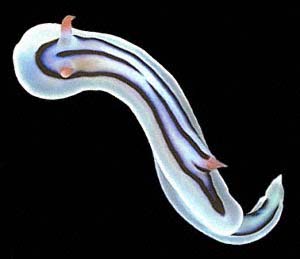
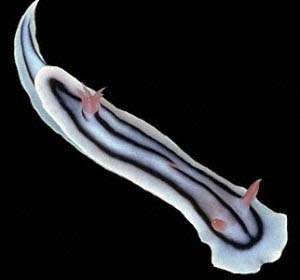
Chromodoris lochi
Rudman, 1982
Order: NUDIBRANCHIA
Suborder: DORIDINA
Family: Chromodorididae
DISTRIBUTION
Tropical Western Pacific
PHOTO
UPPER: Escape Reef,Great Barrier Reef, N of Cairns, Queensland. November 1981.
LOWER: Koumac, New Caledonia, 34mm long alive. October 1993.
PHOTOS: Bill Rudman.
Chromodoris lochi is one of a group of translucent white or bluish-white chromdorids with dark blue or black longitudinal lines. Other species include Chromodoris willani, Chromodoris boucheti and Chromodoris dianae.
Of these whitish species with three black lines, the most characteristic feature of Chromodoris lochi is the plain coloured gills and rhinophores which range in colour from a translucent straw colour to dull orange or pink.
Reference:
• Rudman, W.B. (1982) The Chromodorididae (Opisthobranchia: Mollusca) of the Indo-West Pacific: Chromodoris quadricolor, C. lineolata and Hypselodoris nigrolineata
colour groups. Zoological Journal of the Linnean Society 76: 183-241.
Rudman, W.B., 1999 (March 4) Chromodoris lochi Rudman, 1982. [In] Sea Slug Forum. Australian Museum, Sydney. Available from http://www.seaslugforum.net/find/chroloch
Related messages
Egg mass of Chromodoris lochi from Bunaken (Sulawesi)
April 16, 2010
From: Roy van Grunsven
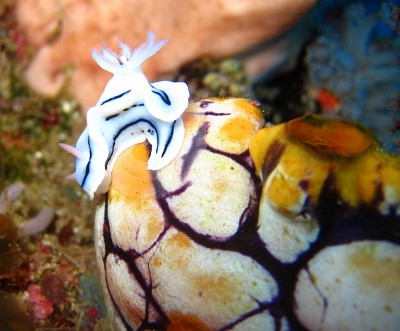
I took this picture on a diving trip to Bunaken and can't figure out which species it is.
Hope you can help me. I believe it has eggs on the seasquirt.
I have pictures of more species but I liked this one best.
Locality: Bunaken NP, 15-20 m, Indonesia, Sulawesi, Celebes sea, 15 october 2009, coral wall. Length: appr. 4 cm. Photographer: Roy van Grunsven.
Thanks
Roy
royvangrunsven@gmail.com
van Grunsven, R.H.A, 2010 (Apr 16) Egg mass of Chromodoris lochi from Bunaken (Sulawesi). [Message in] Sea Slug Forum. Australian Museum, Sydney. Available from http://www.seaslugforum.net/find/23145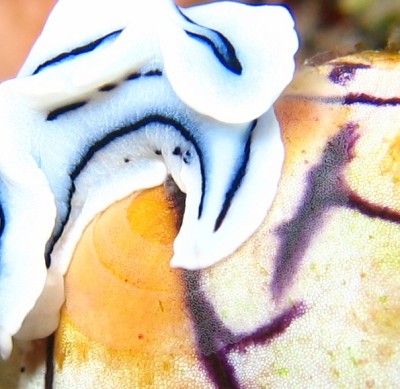
Dear Roy,
This is a colour form of Chromodoris lochi. I am impressed you spotted the almost invisible egg ribbon. This species is one of a group of chromodorids which have a flat egg ribbon. Apart from Cadlinella, all the others appear to belong to a related group most of which have a pattern of longitudinal black lines on the mantle. Although we know C. lochi belonged to this group, our records are so small that another one is always welcome.
Best wishes,
Bill Rudman
Deformed seaslug
May 29, 2009
From: Herbert Kramlofsky
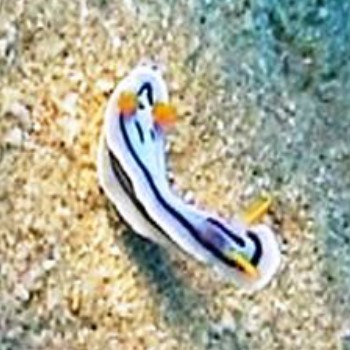
Dear Dr Rudman,
I have got your homepage from Mr. Erwin Koehler, the German seaslug-pope. In November 2008 I was at the island Ambon (Indonesia, Molukku) for diving. When I was home again, I discovered on my video a seaslug with 2 gills, that means 2 openings in the body for the gills. I looked in a book for seaslugs (from Helmut Debelius). So I would say it's a Chromodoris sp.30. I made a picture from this videoscene. You will find it attached to this mail. Of course the quality of this photo is not as good as from a digitalphoto, but one can easy see the details.
Locality: Island Ambon, 8-10 metres, Indonesia, Indian Ocean, Banda Sea, November 2008, sandy bottom. Length: 50-60 mm. Photographer: Herbert Kramlofsky.
Have you ever seen a Chromodoris like this? If you are interested in this seaslug, I could send you this videoscene on DVD.
I am looking forward to your answer.
Respectfully
Herbert Kramlofsky
aswild@freenet.de
Kramlofsky, H,, 2009 (May 29) Deformed seaslug. [Message in] Sea Slug Forum. Australian Museum, Sydney. Available from http://www.seaslugforum.net/find/22506Dear Herbert,
I suspect your animal is Chromodoris lochi. Have a look at my earlier comments [message #22372]. I don't think I have seen an animal with two separate gill clusters like this. I wonder if this means it has two hearts - one for each set of gills? A paired abnormality like this suggest to me that this is the result of a developmental mistake when it was an embryo. It certainly hasn't stopped growing to a good size. It is certainly an addition to the Abnormalities page.
Best wishes,
Bill Rudman
Chromodoris lochifrom Philippines [2], feeding
March 30, 2009
From: Marcel Tanke
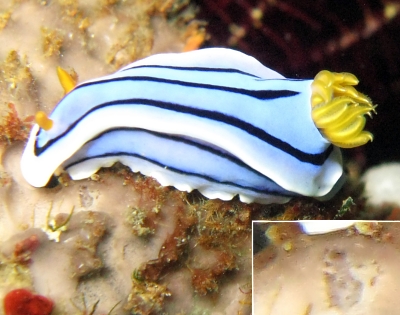
Dear Bill,
Here the second message on this species.
In the first two pictures, they are feeding on a similar type of pinkish sponge. In the second picture the two animals are "guarded" by a moray eel.
The animal in the last picture is feeding on a substrate that I do not recognize.
Locality: Upper photo: Anilao, Dec 2008 - January 2009. Middle photos: Puerto Galera, February 2008. Lower photo: Anilao, Dec 2008 - January 2009. Philippines. Photographer: Marcel Tanke.
Best regards,
Marcel
marceltanke@cs.com
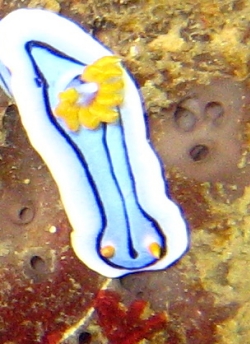
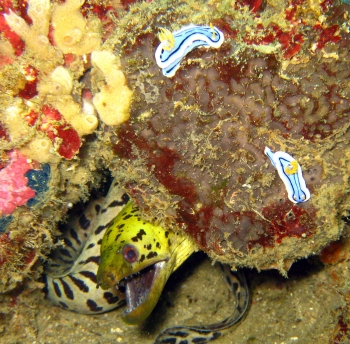
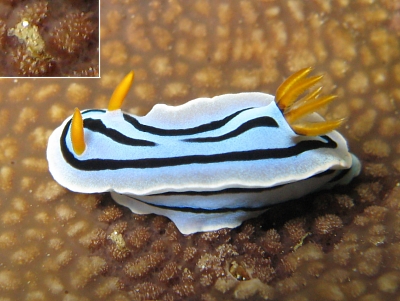
Dear Marcel,
Thanks for these feeding records. The sponge in the upper and middle photos is a thorectid, and either a species of Semitaspongia or Petrosaspongia, which is what we have found it eating before. I am not sure what the the animal is on in your lower photo. I guess it could be a sponge but it is possibly a coral colony.
Best wishes,
Bill Rudman
Chromodoris lochi from Philippines [1]
March 30, 2009
From: Marcel Tanke
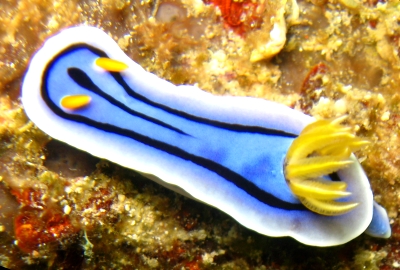
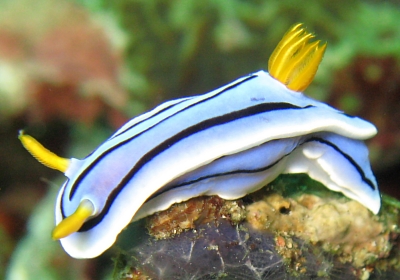
Dear Bill,
I believe the animals in the pictures in this and the next message [#22373], are all chromodorids. They are similar to Chromodoris boucheti, but lack the black line in the gills of that species. All pictures are from different animals.
Locality: Upper photo: Puerto Galera , February 2008; Mid & lower photos: Anilao, Dec 2008 - Jan 2009. Lengths: 2 - 5 cm. Photographer: Marcel Tanke.
Debelius and Kuiter, in their book "Nudibranchs of the world" (2007), call it Chromodoris sp 30.
It's not on your Forum yet?
Best regards,
Marcel
marceltanke@cs.com
Tanke, M.A., 2009 (Mar 30) Chromodoris lochi from Philippines [1]. [Message in] Sea Slug Forum. Australian Museum, Sydney. Available from http://www.seaslugforum.net/find/22372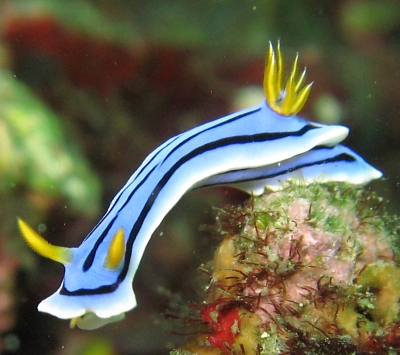
Dear Marcel,
You will see on the C. boucheti Fact Sheet that I say that C. boucheti is 'very similar in colour to Chromodoris lochi and Chromodoris willani.' Your animals are almost certainly Chromodoris lochi. When I first described that species, the only specimens I had seen were from the southwestern Pacific and all of them had translucent - almost colourless - gills and rhinophores. Since then I have seen many specimens - both alive and in photos - with a distinct yellowish colouration to the gills and rhinophores or sometimes and orange pinkish tinge. The colour of your animals look quite like C. elisabethina without the orange border, but one difference is that in C. elisabethina the blue colouration stops at the outer black lines, while in C. lochi the blue extends out to the white margin. I am not sure why some specimens have a distinct yellow colour to the gills and rhinophores, it may be genetic or perhaps its a result of some pigment uptake from their sponge food. We have still a lot to learn.
Best wishes,
Bill Rudman
Chromodoris lochi from Indonesia
August 7, 2007
From: Ken Tucker
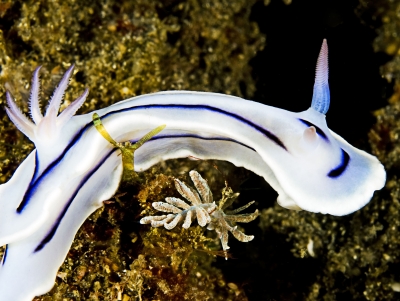
Is the Chromodoris lochi. Seems like a match, though has no median lines, other than the smalldash between the rhinopores, and an even smaller one in front of the gills [not visible in this photo]. I've other photos to confirm.
Locality: North Sulawesi, Lembeh Strait, 10 metres, Indonesia, Celebes Sea, 5 Nov 2005. Length: 2+ cm. Photographer: Ken Tucker.
Ken Tucker
ken@kilili.com
Tucker, K.C., 2007 (Aug 7) Chromodoris lochi from Indonesia. [Message in] Sea Slug Forum. Australian Museum, Sydney. Available from http://www.seaslugforum.net/find/20402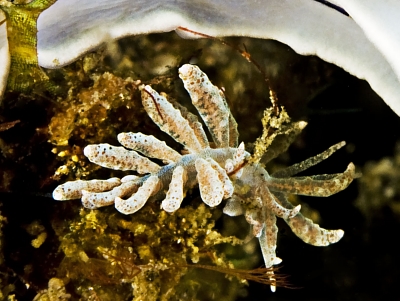
Dear Ken,
Yes this is C. lochi. Its looks very similar to the one on the right of your photos in message #20401. Of more interest [to me] is the nudibranch you haven't mentioned - which looks like a bushy sea weed just below the chromodorid. This is a species of the solar-powered aeolids of the genus Phyllodesmium. I suspect it is Phyllodesmium crypticum.
Best wishes,
Bill Rudman
Chromodoris dianae vs. C. lochi
July 27, 2007
From: Erwin Kodiat
Concerning message #8098:
Hi Bill,
I find it is difficult to distinguish some Chromodoris lochi with yellow gill and rhinopores from C. dianae.
I identify a species as C. lochi if it has pink or yellow tinted translucent rhinophores and gills (but with no white dots like in C. willani). The mantle of C lochi is a uniform colour and smooth looking, without any white specks.
I identify an animal as C. dianae, if it has pale blue based gills and rhinophores, with orange yellow or deep yellow tips, and mantle which has white specks or dots hence not smooth looking.
In this above message, you identify an animal with yellow gills & rhinopores as C. lochi. Can you help me clarify this?
Thanks in advance,
Erwin Kodiat.
info@nudipixel.net
Kodiat, E., 2007 (Jul 27) Chromodoris dianae vs. C. lochi. [Message in] Sea Slug Forum. Australian Museum, Sydney. Available from http://www.seaslugforum.net/find/20016Dear Erwin,
The authors of C. dianae described two colour forms, one with translucent yellow-orange gills and rhinopores and one with gills and rhinophores which were white in the bottom half and yellow in the upper half. I discussed this with the authors and they said all intermediates between the two colour variants could be found. The key difference between C. dianae and C. lochi is not the rhinophore colour but the small white specks all over the mantle in C. dianae. As you say, these white specks are not present on the mantle of C. lochi. Concerning the intense yellow rhinophores and gills we sometimes find in C. lochi, I have looked at the anatomy of a wide variety of animals with different gill colour and can find no differences. That is not to say they may not turn out to be different - the reason I looked at so many was because I had a 'gut feeling' they were different - but I can't see how we can differentiate them at present. I am now beginning to wonder if perhaps food may play a part, but it's very early days on that idea.
Best wishes,
Bill Rudman
Chromodoris dianae? from Nth Sulawesi
June 5, 2007
From: Sebastian Ferse
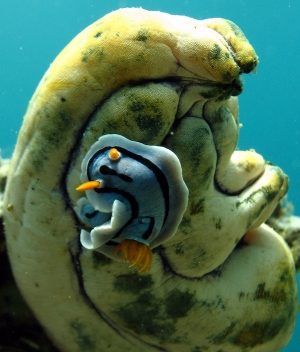
Dear Bill,
Here is an animal from North Sulawesi for which I would like some help on identification. It came from Lembeh Strait, North Sulawesi/Indonesia, close to Pulau Sarena Kecil, from appr. 6 m of water, length of animal about 3 cm. I tentatively identified it as Chromodoris dianae, although the color of the mantle and rhinophores as well as the markings seem slightly different.
Locality: Pulau Sarena Kecil, Lembeh Strait, 6m, North Sulawesi, Indonesia, Pacific Ocean, 18 March 2007, On patch reef exposed to current and surrounded by sandy bottom. Length: 3cm. Photographer: Sebastian Ferse.
Best regards
Sebastian
sebastian.ferse@zmt-bremen.de
Ferse, S.C.A., 2007 (Jun 5) Chromodoris dianae? from Nth Sulawesi. [Message in] Sea Slug Forum. Australian Museum, Sydney. Available from http://www.seaslugforum.net/find/19724Dear Sebastian,
This is Chromodoris lochi
Best wishes,
Bill Rudman
Chromodoris lochi feeding
March 27, 2007
From: Leanne & David Atkinson
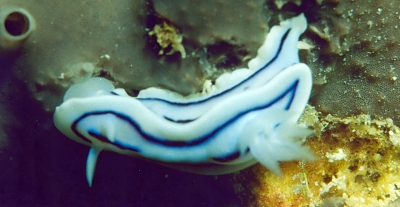
Hi Bill,
You asked for photos of chromodorids feeding on sponges. We were looking through some past photos and came across this group of Chromodoris lochi feeding, and an individual shot showing the mouth parts extended. There also seems to be some damage on the sponge. We have often found these chromodorids on grey sponges. Pleasure Point or Slug Reef as it is known by another dive operation is one of the best dive sites in the Mamanucas for spotting nudibranchs. Both Aquatrek from Mana Island and Subsurface from Musket Cove dive this site.
Locality: Pleasure Point, near Mana Island, 10 metres, Mamanuca Islands, Fiji, Pacific, 17 April 2004, Coral Reef with sponges, soft corals and hard corals. Length: approximately 40 mm. Photographer: Leanne & David Atkinson.
Regards,
Leanne & David Atkinson
atk@hunterlink.net.au

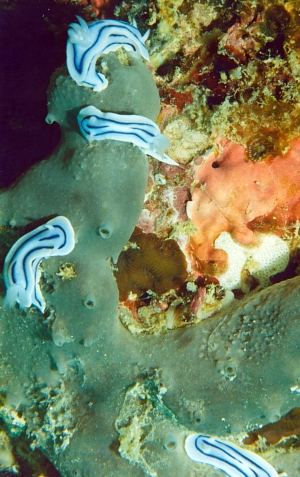
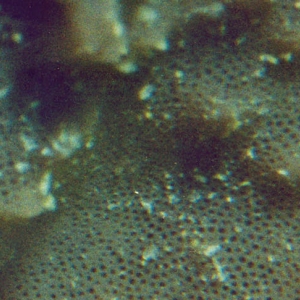
Dear Leanne & David,
Thanks for another record of C. lochi feeding. I am pretty sure this grey sponge is Petrosaspongia mycofijiensis, a thorectid with rather variable shape. I have included a couple of close-ups of the sponge to show this variability
Best wishes,
Bill Rudman
Re: Chromodoris willani & C. boucheti
February 22, 2007
From: Bob Whorton
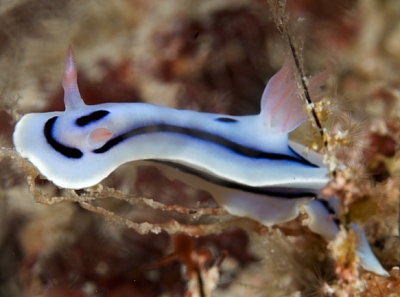
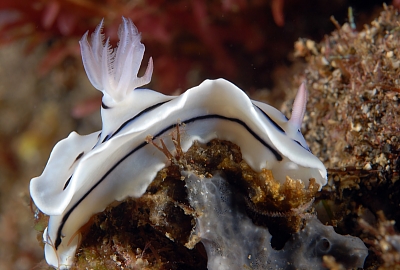
Concerning message #19469:
Hi Bill,
Thanks for clearing up the confusion a little more and ID'ing the variation on C. dianae. Yes regarding C. lochi - Uploaded wrong file :(
Such is my filing system.
Here are 3 Chromodoris lochi shots, one orange and two pink.
Locality: Halmahera/Raja Ampat, 12m, Indonesia, Halmahera Sea, July 2006, Typical sloping reef with coral outcrops. Length: 3 cm +. Photographer: Bob Whorton.
Off again next week to Misool, so I'll be more clued up and vigilant.
Thanks again
Bob
DrBob.Whorton@btinternet.com
Whorton, R., 2007 (Feb 22) Re: Chromodoris willani & C. boucheti. [Message in] Sea Slug Forum. Australian Museum, Sydney. Available from http://www.seaslugforum.net/find/19507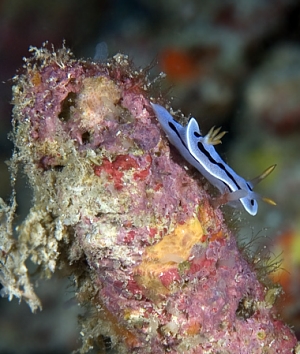
Thanks Bob,
I didn't think of the possibility you had sent the wrong image file. Usually when wrong files are sent with messages it is very obvious. I'm glad to hear you are on your way back to 'black stripe' territory. I look forward to photos of sponge feeding, egg masses, etc.
Best wishes,
Bill Rudman
Chromodoris lochi feeding?
January 17, 2007
From: Colin Teo
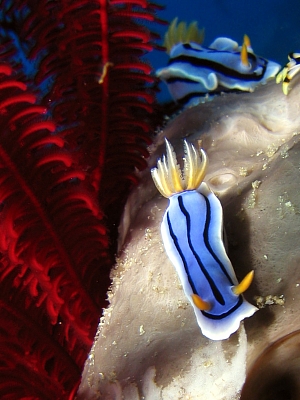
Hi Bill,
Someone mentioned that you might like to see a picture of this nudi on it's possible food sponge so I thought I'll just send it to you.
Locality: Bunaken, Manado, Indonesia, 12 November 2004. Photographer: Colin Teo.
Best Regards,
Colin
colin_teo@yahoo.com
Teo, C., 2007 (Jan 17) Chromodoris lochi feeding?. [Message in] Sea Slug Forum. Australian Museum, Sydney. Available from http://www.seaslugforum.net/find/19154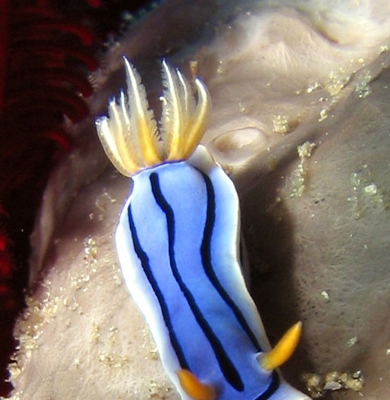
Dear Colin,
'Someone' gave you good advice. I am always happy to get photos of nudibranchs 'doing things', and feeding or potential feeding photos are particularly welcome. Although I can't see any sign of actual feeding, the fact that there are two animals taking more than a passing interest in this sponge is a good sign. Secondly the sponge, is grey and solid, suggesting that it could be the thorectid Petrosaspongia which is the preferred food of this species.
Best wishes,
Bill Rudman
Chromodoris lochi from Lembeh Strait
January 15, 2007
From: Wyatt Ang
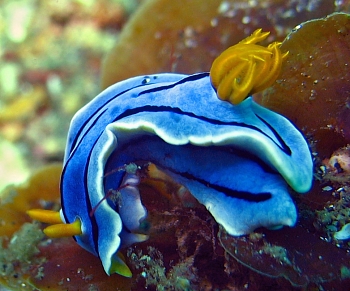
Hi Bill,
I need your expertise yet again. This bluish white species of Chromodoris looks like a combination of C. annae, C. dianae, C. willani and C. elisabethina althogether. I have difficulties distinguishing and identifying this specimen. It has yellow rhinophores and gills but lack the obvious white specks present in C.willani. It looks like C. elisabethina but lacks the continous yellow/ faint yellow margin. It also has a discontinous black median line which is not characteristic in C. annae. Its mantle skirt and foot looks like C. dianae but the the black line markings, the all yellow gills and bluish pits/specks are typically not of C. dianae. So which is it?
Locality: Lembeh Strait, 7m, Indonesia, Mollucca Sea, 13 November 2006, Coral reef with sponges, Silty, black volcanic sand. Length: 50 mm. Photographer: Wyatt Ang.
Regards
Wyatt
wyattang@gmail.com
Ang, W.L, 2007 (Jan 15) Chromodoris lochi from Lembeh Strait. [Message in] Sea Slug Forum. Australian Museum, Sydney. Available from http://www.seaslugforum.net/find/19212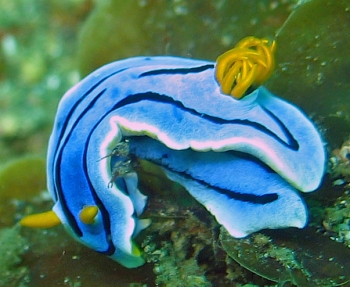
Dear Wyatt,
One species you don't include in your comparison is Chromodoris lochi which is quite similar in colour to C. willani but has yellowish gills and rhinophores and a narrower mantle skirt. This species seems to range from animals with a very pale whitish background colour to ones like yours with a bluish tinge to the body..
Best wishes,
Bill Rudman
Chromodoris lochi? from Malaysia
September 9, 2006
From: Kenneth Yong
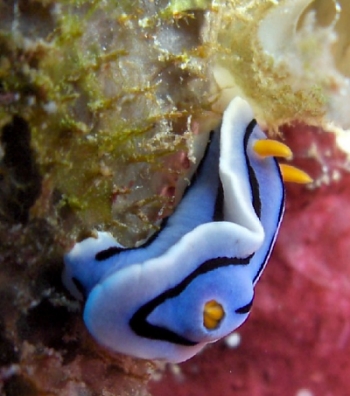
Hello,
Is this Chromodoris annae? It doesn't have the yellow margin, but looks quite a bit like the colour form another person had sent you on 16 April, 2002.
Locality: Mid-Reef, Layang-layang Atoll, 25 m, Malaysia, South China Sea, 06 August 2006. Length: 4-5 cm. Photographer: Kenneth Yong.
Again, thanks a million for your help.
Cordially,
Kenneth
k.yong@tiscali.it
Yong, K., 2006 (Sep 9) Chromodoris lochi? from Malaysia. [Message in] Sea Slug Forum. Australian Museum, Sydney. Available from http://www.seaslugforum.net/find/17660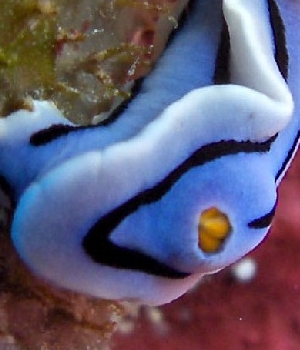
Dear Kenneth,
This is probably Chromodoris lochi. The colours are a little more intense than normal but I think that is part of the variability in the species. Another difference you can see in the close-up is that the bluish colour is uniform, while C. annae is one of the species in which there are distinct dark specks all over the blue background colour. We call this speckled pattern a punctate pattern.
I suspect the whitish object the slug is on is its food sponge, but I can't see enough detail to be sure
Best wishes,
Bill Rudman
Chromodoris lochi feeding
July 24, 2006
From: Pat Bergquist
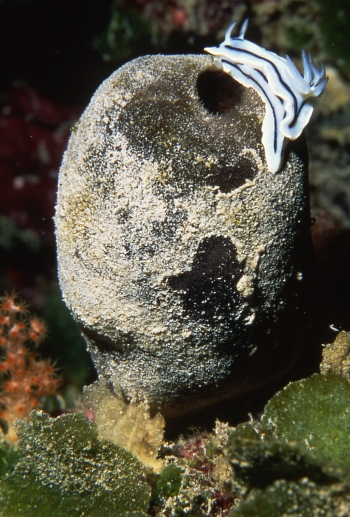
Dear Bill
I thought you would like another feeding record of Chromodoris lochi. Having examined the sponge, I can confirm that it is the thorectid Petrosaspongia mycofijiensis.
Locality: Tobi Island, Palau. Depth 20 m, 13 December 1996. on overhang/wall. Sponge diam 4-7 cm; height 7-15 cm. The photo and the specimen are in the collections of the Coral Reef Research Foundation [Specimen OCDN4462-K].
Thanks to Lori Bell & Dr P. Colin, Coral Reef Research Foundation, for allowing us to use this information. Collections by the CRRF were made under contract N02-CM-77249 to the US National Cancer Institute. Collections were made under permits from Hatohobei State and the Bureau of Marine Resources, Republic of Palau.
Best wishes
Pat Bergquist
University of Auckland, N.Z..
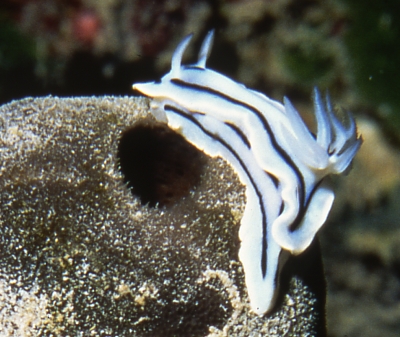
Dear Pat,
The blackish patches are good evidence of feeding activity. Thanks for this identification. As you well know, this sponge, although described relatively recently, has a confused and confusing nomenclatural history. First considered a spongiid (Spongia mycofijiensis Kakou, Crews & Bakus, 1987) it has more recently been shown by you to be a thorectid (Bergquist, Sorokin & Karuso, 1999).
It has been referred to quite often in the chemical literature under various names, including Spongia mycofijiensis and Cacospongia mycofijiensis, as its secondary metabolites, like those of many sponges, are of great interest to natural products chemists as a potential cure for cancer, heart disease, ... or almost anything that causes disease.
Best wishes,
Bill Rudman
Chromodoris dianae and C. lochi from Borneo.
March 8, 2006
From: Asther Lau
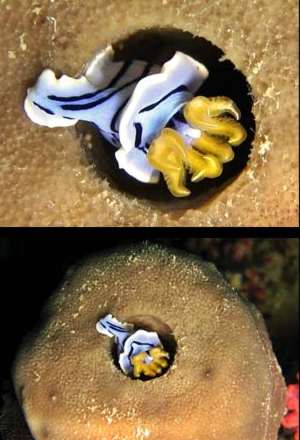
Hi Bill,
Here are two images, possibly color variation of Chromodoris dianae. The one hiding in the sponge coral has full orange gills. However, the other has orange tips on its gills.
Locality: Mid Reef, Sipadan Is. Sabah, Malaysia, Celebes Sea. Depth: 20 metres. Length: 2 cm but can't determine the one hiding. 14 March 2004. Wall of Coral Reef. Photographer: Asther M. Lau
Please confirm if these two are the same species.
Thank you!
Asther M. Lau
asther@astherlau.com
Lau, A, 2006 (Mar 8) Chromodoris dianae and C. lochi from Borneo.. [Message in] Sea Slug Forum. Australian Museum, Sydney. Available from http://www.seaslugforum.net/find/15446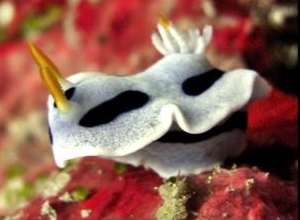
Dear Asther,
When C. dianae was first described it included animals like you lower photo with only the upper half of the gills yellow and animals with all the gills yellow. Bernard Picton [#4665] illustrates the variety. What all the colour forms have in common are white specks all over the mantle. I am pretty sure your animal in the top photos is Chromodoris lochi. The sponge with the 'hole' is a common food of a group of these species [see message #12000]
Best wishes,
Bill Rudman
Re: Chromodoris lochi on sponges
April 11, 2005
From: Francesco Ricciardi
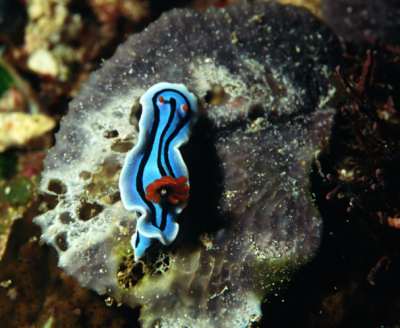
Dear Bill,
I found your comments [#12037 ] about the feeding behaviour of Chromodoris lochi. This specimen - I think it is C. lochi, but the red colour of rhinophores and gills makes me uncertain - was feeding on an encrusting sponge.
Locality: Bunaken Island, North Sulawesi, Indonesia, Indo-Pacific. Depth: 18 m. Length: 3 cm. Photographer: Francesco Ricciardi
Francesco Ricciardi
francesco.ricciardi@unimi.it
Ricciardi, F., 2005 (Apr 11) Re: Chromodoris lochi on sponges. [Message in] Sea Slug Forum. Australian Museum, Sydney. Available from http://www.seaslugforum.net/find/13456Dear Francesco,
Thanks for this, the partly eaten part shows the sponge structure quite well so should help to identify it. The red gills and rhinophores are part of the normal variation in this species
Best wishes,
Bill Rudman
Chromodoris lochi on sponges
January 29, 2004
From: Roberto Sozzani
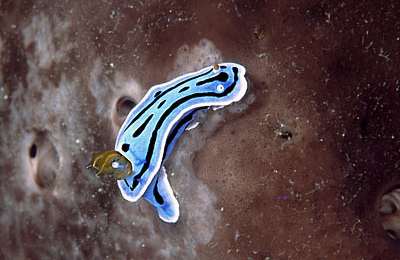
Dear Bill,
I checked my photos from Manado (Indonesia) for more Chromodoris on sponge(s) and found these two of Chromodoris lochi.
Upper photo was shot on March 2002, the lower left one on June 2003. Depth between 10 to 20 meters.
In the enlargement of the first photo, it seems the sponge is covered by something or maybe it has been damaged by the Chromodoris feeding?
Best regards
Roberto Sozzani
roberto.sozzani@fastwebnet.it
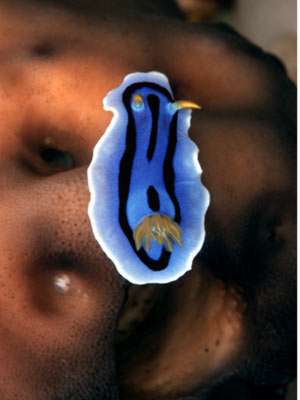
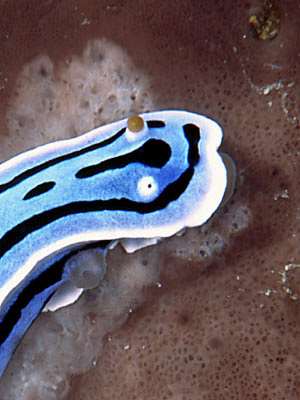
Thanks Roberto,
We have very little information on whta this species eats so this is welcome information
Best wishes
Bill Rudman
Very small chromodorid
November 14, 2003
From: Gary Cobb
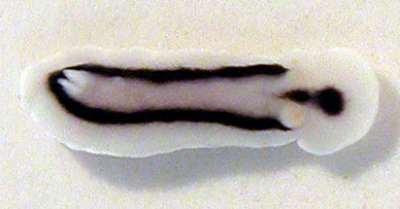
Hi Bill!
Please find attached a photo of a 4mm nudibranch. Could it be Chromodoris lochi? Found on the Wall, Old Woman Is, Sunshine Coast, Qeensland, Australia. Depth 9m, Size 4mm, found on a rock water temp 22 degrees Celcius.
When I was photographing it it would turn AWAY from the light all the time and appear to try to get as far as possible from it. Is this a trait of this animal?
Do they try and avoid light and maybe try to hide?
Thanks for your help
Gary Cobb
gary@cobb.com.au
Cobb, G., 2003 (Nov 14) Very small chromodorid. [Message in] Sea Slug Forum. Australian Museum, Sydney. Available from http://www.seaslugforum.net/find/11379Dear Gary,
At this size it is a bit difficult to be sure but I suspect it is C. lochi. Concerning sensitivity to light, it seems that many nudibranchs are 'negatively phototactic' - that is they move away from light. I guess this is a useful adaptation so they end up under rocks and overhangs which makes them less visible to predatory fish, and in intertidal regions it means they are in the shade and so less likely to dry out at low tide. However so few species have been studied that it would be wrong to say this is a general rule
Best wishes
Bill Rudman
Chromodoris lochi at Layang Layang
May 22, 2003
From: Kheong San Chang
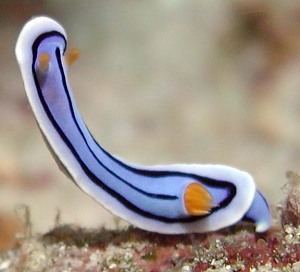
Dear Bill,
Here are some photos of a nudi exhibiting a similar behaviour to one I posted before. He lifted his front end up and kind of sniffed around to find his way. Could you ID this slug for me?
The Layang trip was at the end of March, 2003. This nudi was shot on Mar 29. Layang Layang is an atoll which then drops thousands of meters into the sea. The edge is a wall dive, but the atoll itself has a sandy bottom which is more or less completely covered with coral towards the edge. Inside the atoll seems to be mostly sand. The nudi is around 5cm long. [Layang Layang, also known as Swallows Reef, is 300 km northwest of Kota Kinabalu, Sabah, Malaysia in the South China Sea].
Kheong.
kschan@mail.dsi.nus.edu.sg
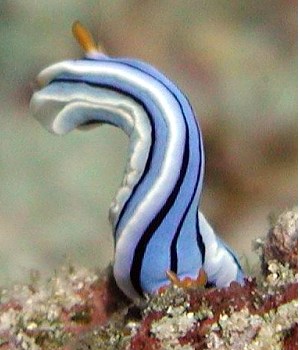
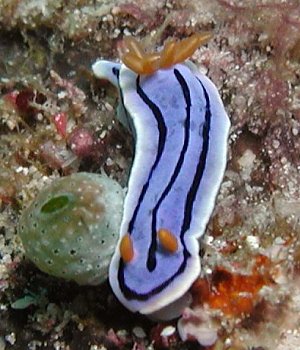
Dear Kheong,
This is Chromodoris lochi. I suspect that as well as 'smelling' your slug is 'feeling' around for something more interesting to crawl on.
Best wishes,
Bill Rudman
Chromodoris lochi from Yap
January 27, 2003
From: Steven Fisher
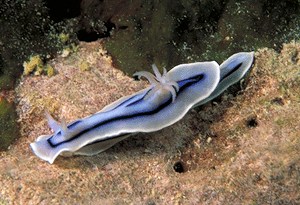
Found this nudibranch in Yap on a night dive, about 15 meters depth. Size was about 3cm long.
Would like Species ID.
Steven Fisher
fisheyeviewphoto@aol.com
Fisher, S., 2003 (Jan 27) Chromodoris lochi from Yap. [Message in] Sea Slug Forum. Australian Museum, Sydney. Available from http://www.seaslugforum.net/find/9002Dear Steve,
This is Chromodoris lochi. For those of you who don't know where Yap is, it is part of Micronesia, and located in the Western Carolines, about midway between Guam and sthn Philippines.
Cheers,
Bill Rudman
Nudi behaviour question
December 13, 2002
From: Ken Howard
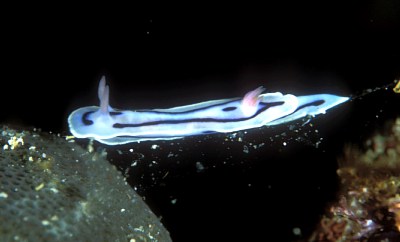
Hi Bill,
I was attracted to the behavior of this nudibranch in the Solomon Is. last month. The JPEGS are in sequence. In photos 1 and 2 [lower left], it was arching its body out over this gap in the coral. It then crawled down the coral head it was on and proceeded to cross over [other photos] on what looks to me like a mucus 'bridge'. My question — do you know if the nudibranch could have excreted the 'bridge' itself, or did it just sense it was there already? There are a fair amount of sand particles, etc. on the 'bridge' so I think it had been around for a while — just wanted to try and find out if the nudi could have created it previously, or was just making use of what another critter manufactured.
Thanks in advance for your help!
Best wishes for the Holidays,
Ken
khoward@seaimages.org
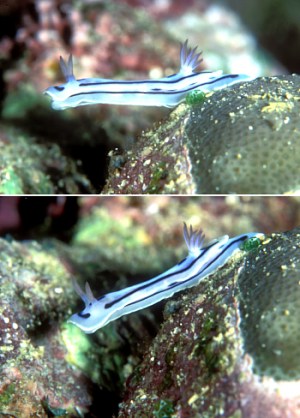
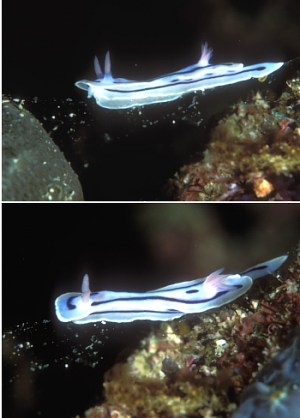
Thanks Ken,
The stretching out over a gap behaviour you describe in the lower left photos is typical behaviour of many nudibranchs. It's obviously a searching behaviour, looking for somewhere else [more interesting?] to go. The mucus bridge you describe, which we can see in some of the other photos, is almost certainly produced by the coral colony. The coral looks to be a species of Porites. Many corals, including Porites, clean themselves when covered in silt or sandy particles by producing large quantities of mucus, which form a sticky layer over the colony. This layer sloughs off with the unwanted particles attached. If there is water movement the mucus layer drifts off. As the mucus continues to be produced for some time you get this phenomenon of the coral colony producing a streaming mucus layer which could indeed form the 'bridge' you describe. So my guess is the nudibranch, Chromodoris lochi, is just using a temporary bridge formed from this streaming mucus to get across the gap between the two coral colonies.
Cheers,
Bill Rudman
Chromodoris lochi from Northern Sulawesi
October 7, 2002
From: Marli Wakeling
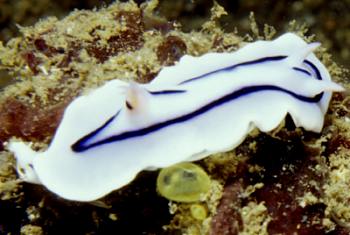
Hi Bill,
More nudibranchs from Nudi Falls. Here is Chromodoris lochi.
Location: Nudi Falls, Lembeh Straight, North Suluwesi, Indonesia.
Date: July, 2002
Depth: 30 feet
Length: 4 cm.
Photograph: Marli Wakeling
Regards,
Marli
scubamarli@excite.com
Wakeling, M., 2002 (Oct 7) Chromodoris lochi from Northern Sulawesi. [Message in] Sea Slug Forum. Australian Museum, Sydney. Available from http://www.seaslugforum.net/find/8094Thanks Marli,
Bill Rudman
Chromodoris dianae? from North Sulawesi
October 7, 2002
From: Marli Wakeling
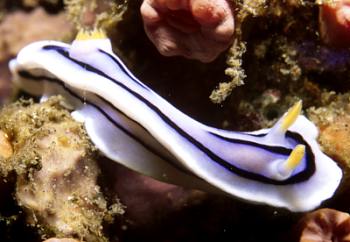
Hi Bill,
I had a little difficulty with this one. It looks a lot like Chromodoris lochi, which was present at the site, and which I will send in a separate message. However the gills and rhinophores were definitely orange, not pink. Is it Chromodoris dianae?
Location: Nudi Retreat, Lembeh Straight, North Suluwesi, Indonesia.
Date: July, 2002
Depth: 45 feet
Length: 3 cm.
Photograph: Marli Wakeling
Cheers,
Marli
scubamarli@excite.com
Wakeling, M., 2002 (Oct 7) Chromodoris dianae? from North Sulawesi. [Message in] Sea Slug Forum. Australian Museum, Sydney. Available from http://www.seaslugforum.net/find/8098Dear Marli,
As I have said in another message, I am at present considering these different gill colours to be variants of C. lochi.
Best wishes,
Bill Rudman
Another Chromodoris lochi from North Sulawesi
October 7, 2002
From: Marli Wakeling
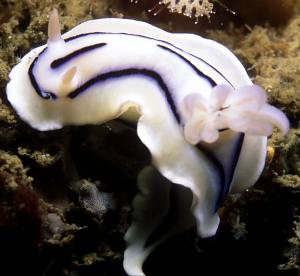
Hi Bill,
Here is the Chromodoris lochi that is so close to the animal in my previous message, but this one has the distinctive pink gills and rhinophores.
Location: Nudi Retreat, Lembeh Straight, North Suluwesi, Indonesia.
Date: July, 2002
Depth: 45 feet
Length: 3 cm.
Photograph: Marli Wakeling
Cheers,
Marli
scubamarli@excite.com
Wakeling, M., 2002 (Oct 7) Another Chromodoris lochi from North Sulawesi. [Message in] Sea Slug Forum. Australian Museum, Sydney. Available from http://www.seaslugforum.net/find/8099Dear Marli,
At this stage I am considering the three gill colours you have found, translucent, yellow-orange, and the pink in this message to be the same species. I have looked at a lot of radulae but can't find any differences. I realise that similar radular morphology doesn't automatically mean same species, but I can't find any other anatomical differences which can be tied to gill colour, so the simplest course is to leave them together. If anyone wants to start looking for different egg ribbons and different food choices, then that would be very useful.
Best wishes.
Bill Rudman
Chromodoris lochi from Fiji
April 9, 2002
From: Daniel Geiger
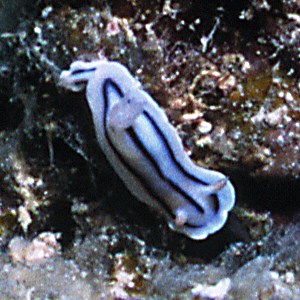
Hi Bill
Here are some new photos
5252 Chromodoris sp. Fiji, Site #19, Sept. 2001, 15m depth, coral reef, pavement sand, with coral heads, dorid approx. 2 cm long. Took this photo with a 24 mm lens, so the specimen is a bit small, which will
explain the grainy image.
Daniel.
dgeiger@nhm.org
Geiger, D., 2002 (Apr 9) Chromodoris lochi from Fiji. [Message in] Sea Slug Forum. Australian Museum, Sydney. Available from http://www.seaslugforum.net/find/5442Dear Daniel,
This is Chromodoris lochi.
Best wishes,
Bill Rudman.
Chromodoris lochi from Papua New Guinea
November 10, 2001
From: Marli Wakeling
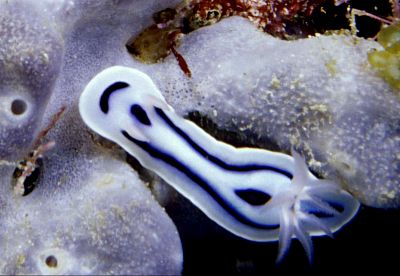
Hi Bill,
Here is a Chromodoris lochi I found whilst in Papua New Guinea this past summer [July 2001]. Is the purple sponge its food souce?
Dive Site: Bauddison's Island (near Kavieng), Papua New Guinea
Depth: 20 metres
Length: 35mm
Marli
scubamarli@excite.com
Wakeling, M., 2001 (Nov 10) Chromodoris lochi from Papua New Guinea. [Message in] Sea Slug Forum. Australian Museum, Sydney. Available from http://www.seaslugforum.net/find/5524Dear Marli,
The sponge does look interesting. It could easily be its food. certainly something worth looking out for in future.
Best wishes,
Bill Rudman
Chromodoris lochi from Sulawesi
October 4, 2001
From: Jim Anderson
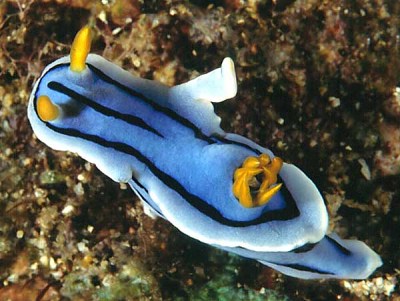
Dear Dr. Rudman,
I have been classifying images such as the attached as C. dianae on my new Sulawesi Sea Slugs site. Erwin Koehler has suggested that 02 and 03 are C. lochi . The attached has been in the wars it would appear, but was still going about its business. Please advise.
Kind regards,
Jim Anderson
jander4454@aol.com
Anderson, 2001 (Oct 4) Chromodoris lochi from Sulawesi. [Message in] Sea Slug Forum. Australian Museum, Sydney. Available from http://www.seaslugforum.net/find/5010Dear Jim,
Animals from the Malay/Indonesian Arc tend to be more blue than those from the Pacific, but I still think they are all Chromodoris lochi. In C. dianae the black is arranged differently and the background colour has a punctate pattern suggesting the skin is covered in small pits.
Best wishes,
Bill Rudman
Chromodoris lochi from Solomon Islands
June 27, 2001
From: Jeff Rosenfeld
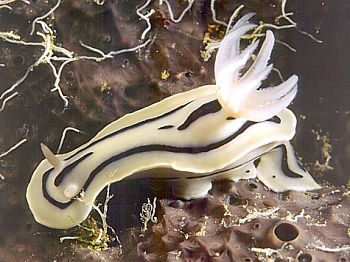
Hi Bill,
Here's an individual I found in the Florida Islands, Solomon Islands in August, 1998 that seems to be Chromodoris lochi.
However, I haven't found any mention of this yellowish color form in the various sources I've investigated. Any thoughts?
[There is a larger copy of this photo at http://www.oz.net/~vibrant/lochi14_floridas1.html.]
Thanks!
Jeff
jhrosenfeld@seattleschools.org
Rosenfeld, J., 2001 (Jun 27) Chromodoris lochi from Solomon Islands. [Message in] Sea Slug Forum. Australian Museum, Sydney. Available from http://www.seaslugforum.net/find/4681Dear Jeff,
The background colour on some of these animals depends on their size and sometimes on where they are photographed. This creamy colour is not unusual. Sometimes the black lines can have quite a bluish tinge. I must say the sponge it is on looks tempting, but proximity, in itself, is not evidence that it is a food item.
Best wishes,
Bill Rudman
Chromodoris lochi - 3 rhinophores
April 4, 2001
From: Erwin Koehler
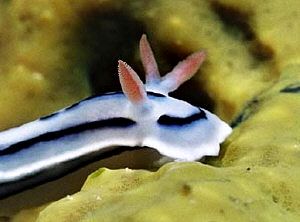
Dear Bill
Attached is a photo from Papua New Guinea
taken by Beate and Peter Lange
email: beate.lange@aon.at
other data were not recorded.
Interesting is the split rhinopore
Erwin
Erwin@medslugs.de
Koehler, E., 2001 (Apr 4) Chromodoris lochi - 3 rhinophores. [Message in] Sea Slug Forum. Australian Museum, Sydney. Available from http://www.seaslugforum.net/find/4093Thanks Erwin,
Developmental abnormalities seem to be a lot more common than I first thought
Best wishes,
Bill Rudman
Chromodoris lochi genitals
March 21, 2001
From: Mary Jane Adams
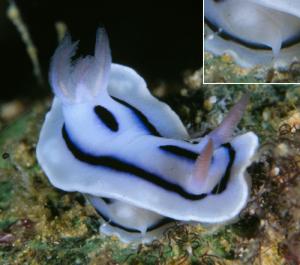
Hi Bill,
This Chromodoris lochi was crawling around by itself, so why are its genitals everted? Sambulo Island, Marovo Lagoon, Solomon Islands, November, 2000.
Best regards,
Mary Jane
divepng@yahoo.com
Adams, M.J., 2001 (Mar 21) Chromodoris lochi genitals. [Message in] Sea Slug Forum. Australian Museum, Sydney. Available from http://www.seaslugforum.net/find/3711Dear Mary Jane,
The short answer is that I have no idea. From my limited experience, eversion of the penis usually doesn't take place until after they have made physical contact. Perhaps someone can enlighten us.
Best wishes,
Bill Rudman
Is this Chromodoris lochi
October 17, 2000
From: Des Paroz
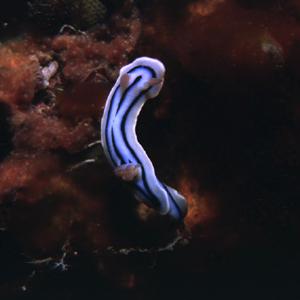
Hi Bill
Saw this one in about 25m on Trigger Happy, Flinders Reef, Coral Sea.
I think its Chromodoris lochi, but I am not 100% sure - it might be a colour variation of some other Chromodoris.
Best regards
Des Paroz
www.divesite.paroz.com
des@paroz.com
Paroz, D., 2000 (Oct 17) Is this Chromodoris lochi. [Message in] Sea Slug Forum. Australian Museum, Sydney. Available from http://www.seaslugforum.net/find/3153Dear Des,
The only species C. lochi can really be mistaken for in the South Pacific is Chromodoris willani which has white spots on the gills and the rhinophore clubs. Have a look at the photo in an earlier message of both species together.
I used to think C. lochi always had translucent straw coloured gills and rhinophore clubs but they can in fact vary in colour to orange and almost red. However they are always translucent and the colouration is uniform, with no spots or lines.
Best wishes,
Bill Rudman.
Chromodoris lochi from Papua New Guinea
July 12, 1999
From: Des Paroz
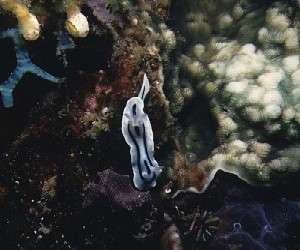
Dear Bill
Here is another nudibranch from Papua New Guinea (Kavieng & Wallindi) May 1999, I would like identified for my DIVESITE at http://www.divesite.paroz.com.
Best regards
Des Paroz
des@paroz.com
Paroz, D., 1999 (Jul 12) Chromodoris lochi from Papua New Guinea. [Message in] Sea Slug Forum. Australian Museum, Sydney. Available from http://www.seaslugforum.net/find/1037Dear Des,
I am pretty sure this is Chromodoris lochi. There is a slight chance it is Chromodoris willani but I can't see the gills clearly enough in your photo to be certain. In Chromodoris lochi the gills and rhinophores are a translucent straw colour while on Chromodoris willani there are distinctive white patches. Have a look at the photo of both species together I have put in my answer to Gordon Smith's message at the bottom of this page.
Bill Rudman.
Rudman, W.B., 1999 (Jul 12). Comment on Chromodoris lochi from Papua New Guinea by Des Paroz. [Message in] Sea Slug Forum. Australian Museum, Sydney. Available from http://www.seaslugforum.net/find/1037Chromodoris lochi? from Philippines
June 19, 1999
From: Erwin Koehler
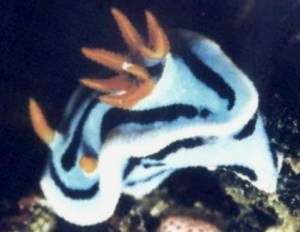
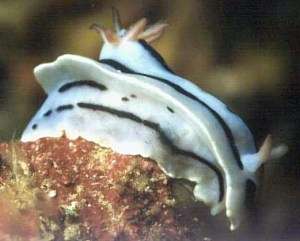
Bill,
here are 2 photos by Dieter Riexinger, Germany, RIEXING@de.ibm.com
They are from Panglao Is., Philippines, March 1999, size not recorded. Is it Chromodoris lochi or Chromodoris boucheti or something else?
Erwin
Medslugs.Koehler@t-online.de
Koehler, E., 1999 (Jun 19) Chromodoris lochi? from Philippines. [Message in] Sea Slug Forum. Australian Museum, Sydney. Available from http://www.seaslugforum.net/find/948Dear Erwin,
It is Chromodoris lochi. If you look at the photos throughout the page you will other specimens with the darker orange-red gills. It differs from other similarly coloured species such as Chromodoris dianae and Chromodoris willani, in having uniformly coloured gills. I will try and find time to prepare a page on Chromodoris boucheti so all the similarly coloured species can be compared.
best wishes,
Bill Rudman.
Chromodoris willani or C. lochi?
March 4, 1999
From: Gordon T. Smith
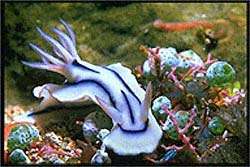
Dear Bill,
Hi, I am pretty new to the net so please bear with me if I screw things up sending files etc.
I have a shot that I identified using Helmut Debelius' book as Chromodoris willani (p203)and enclose it with this message. Can you confirm this as I have been informed that it is possibly C. lochi.
I have built a website which includes many nudibranch shots: http://www.angelfire.com/mi/sharkcage69/index.html
Regards,
Gordon.
aquashot@emirates.net.ae
Smith, G.T., 1999 (Mar 4) Chromodoris willani or C. lochi?. [Message in] Sea Slug Forum. Australian Museum, Sydney. Available from http://www.seaslugforum.net/find/629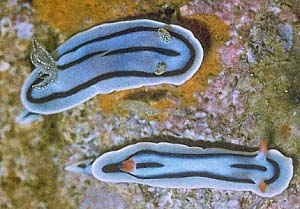
Dear Gordon,
I had a look at your interesting site last week and meant to let you know that your Plakobranchus is in fact a species of Elysia but I'm not sure which one.
Concerning your photo. It is Chromodoris lochi rather than C. willani. By chance I have a photo of the two together, taken by Richard Willan from Efate Is, Vanuatu, 18m, July 1976. The top animal is the holotype of Chromodoris willani and the lower one is Chromodoris lochi.
The main external distinguishing character of
Chromodoris willani is the white patching all over the translucent gills and rhinophores. If you have a look at the page on Chromodoris willani you will see I have included closeups of these structures so you can see the colour pattern. I have included some pictures of Chromodoris lochi at the top of this page above your message.
If you want to send any other unknown pictures, or interesting shots, to the Forum I would be glad to have them, especially things from the Red Sea and surrounding areas.
Best wishes,
Bill Rudman.
